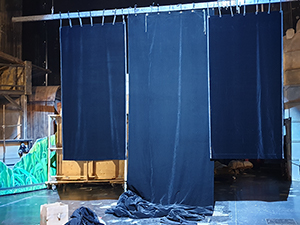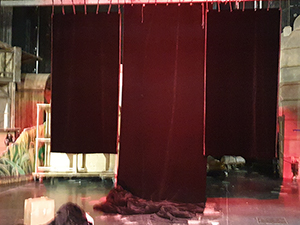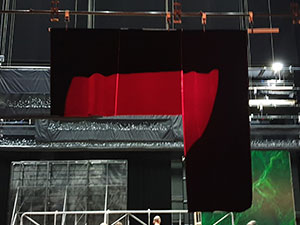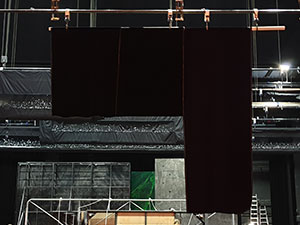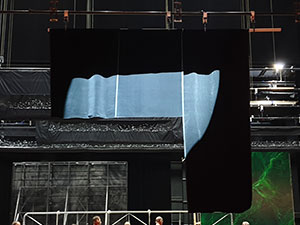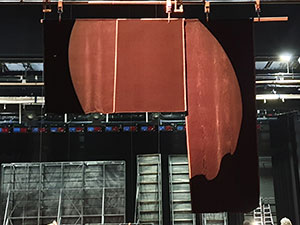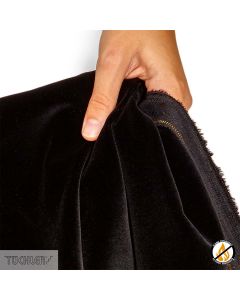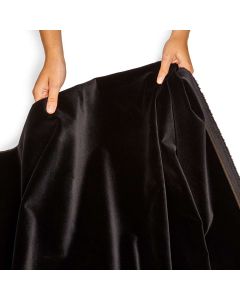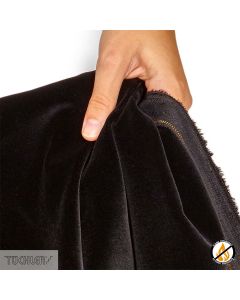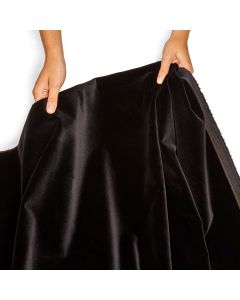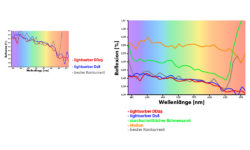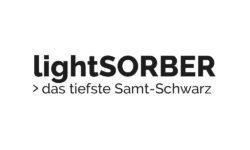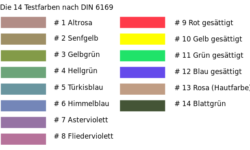For your stage display: deep black highTex velvets of the lightSORBER class
The deepest possible black for your theatre or opera house in every light, whether filament lamp, HMI, HQI, LED etc. for theatre horizons, backdrops, aisle scarves and soffits.
Along with the technical evolution of light sources, the requirements for black stage displays have changed over the years. Until 1945, only light sources with filaments and with or without halogen were in use. HMI light sources first came onto the market in the 1950s. Since the 2010s, theatre fixtures based on LED technology are being used more and more on the world’s theatre stages. Most theatres use different light sources in parallel.
With the technical evolution of light sources, the requirements for black stage displays changed over the decades. Until 1945, only light sources with filaments with or without halogen were used, but from the 1950s HMI light sources came onto the market for the first time. Since the 2010s, theatre spotlights based on LED technology have been taking up more and more space on the world's theatre stages. In most theatres, different light sources are used in parallel.
Depending on the technology, light is emitted with a typical spectrum – from the red-heavy light of old tungsten lamps to the spectra of HMI/HQI technology, with a comparatively high proportion of blue, to modern LED technology, where the red colour spectrum is almost completely missing. All this is a huge challenge for the colour black.
For maximum darkness of your stage materials in every light: lightSORBER class stage velvets
In order to make your entire stage display – soffits, aisle scarves, theatre horizons, backdrops – appear deep black, they must absorb as much luminous flux as possible in every wave length of the light spectrum. Of course, shine is counterproductive and must also be avoided.
We set off on our quest for solutions and found them in new colours and new velvet structures – the highTex stage velvets of the lightSORBER class were born!
lightSORBER Velvets
Live test of lightSORBER on your stage
Several stages are already testing lightSORBER stage velvet DD25 and D18: Photos of the tests show that lightSORBER velvets
- are darker with every light source
- the differences in brightness from colour to colour are smaller. This means that
- a light-up with a certain light colour doesn’t occur.rbe
Transition made easy: This is how to switch to the stage velvet lightSORBER class, without having to replace everything at once.
Black should visually enlarge the depth of your stage and your stage design. The blacker the background, the deeper the overall effect. Start by using the new lightSORBER velvets at the very back of your stage: Begin with a backdrop and follow by replacing soffits and aisle scarves symmetrically, from the back towards the auditorium. Step by step, your stage becomes deep black.
Different deliveries – different colours? Passé!
TÜCHLER achieves state of the art exact colour rendition on velvet through high-precision controlled dyeing processes, meticulous inspection and colour measurements. Thus, you can combine freshly produced and older products in your house. Please take note that velvet curtains in your house may be completely regenerated and therefore can appear darker than recently delivered velvet. This effect is far less noticeable in lightSORBER velvets, but still exists. Your experienced lighting team can easily illuminate this difference away.
Match your echo velvet to the stage curtain: Stage velvet lightSORBER types with acoustically effective backing.
Due to decades of experience, it was clear to us, at TUCHLER, that it was only a matter of time before a theatre or opera house would need a deep black echo curtain to match the lightSORBER theatre stage curtain. Therefore, we developed an acoustically effective backing that transforms lightSORBER D18 and lightSORBER DD25 into perfectly matching echo curtains.
By the way: Sound certificates in accordance with EN 354 are available for all lightSORBER class stage velvets!
Up to 90 % improvement: shelf life/reflecting stripes and recovering from creasing
Velvets have the property of developing so-called reflection stripes on the original roll. The reason for this are micro-movements of the material, that start straight after rolling up and reduce tension produced during the production of the material. The fibres on the velvet surface get slightly tangled and prevent homogeneous tension equalisation. The result are light and dark stripes on velvet fresh off the roll. These stripes disappear over time – but we often don’t have time!
With lightSORBER DD25, we were able to reduce this effect – even after months of storage – by about 90 %. lightSORBER D18 is also a benchmark for long shelf life in its weight class of 600g/m². If reflection stripes occur, both velvets reduce these far more quickly than comparable velvets. The same applies to folds that occur when theatre curtains are folded and stored.
Save time sewing: The flat selvedge with gold thread is tension-free and therefore perfect for beautiful seams.
The quality of the selvedges has a decisive influence on how the velvet curtain hangs. Tension and fibres bulging at the selvedge produce wavy or rippling seams and have to be removed before sewing, which is tedious. lightSORBER velvets have flat and tension-free selvedges, that stay on the velvet and keep the finished curtain seam smooth.
It is only simpler with the TÜCHLER sewing studio:
Our modern rail-guided sewing machines set seams completely straight over the whole height of the curtain. This is ideal for stage curtains, that need to fall extremely flat without adding pleats.

